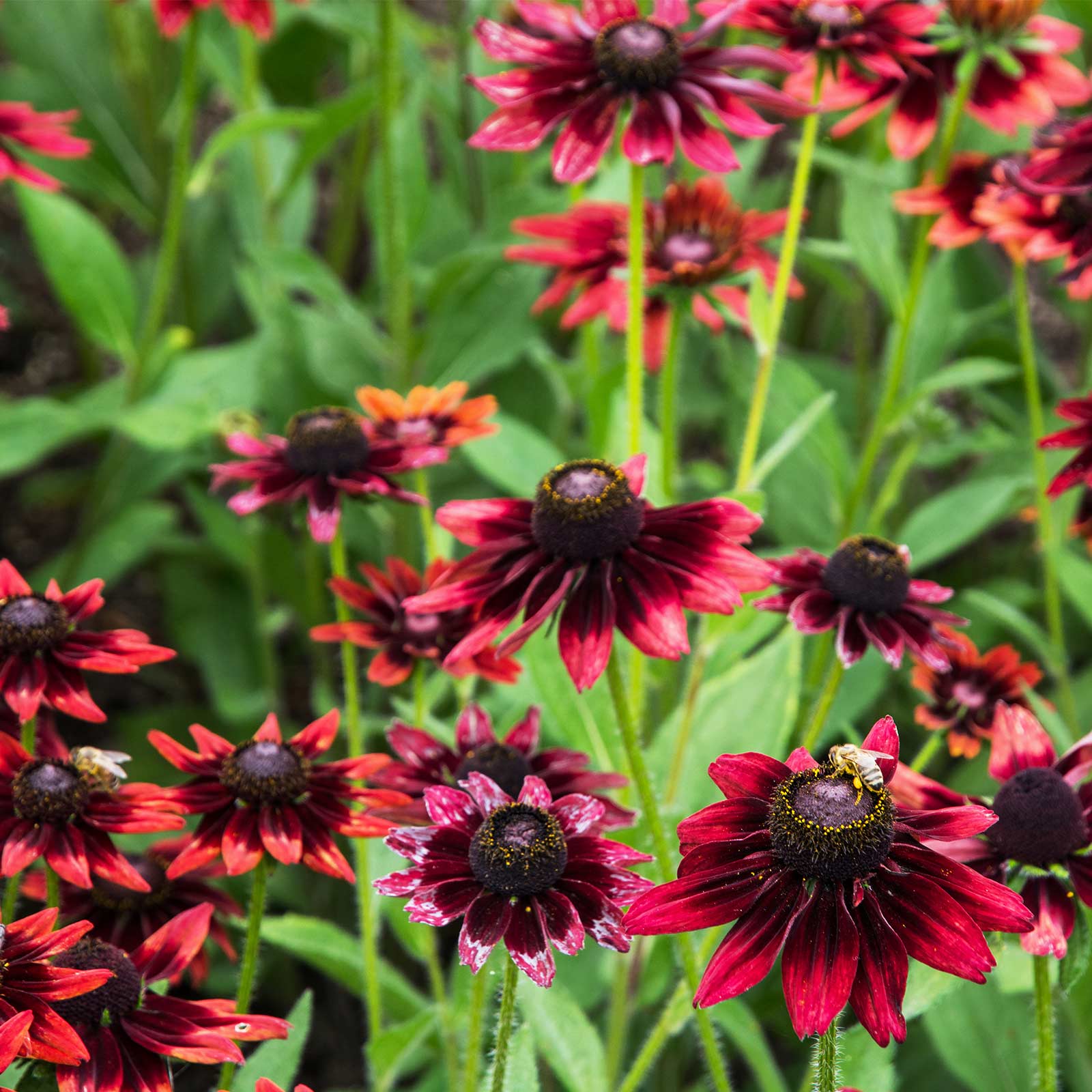- Home
- Beyond organic gardening
- Best Air Purifying Plants
8 Best Air Purifying Plants for Your Home

Indoor air quality has become a valid concern in recent years. Poor air quality can contribute to allergies and long-term health issues. Yet, according to the EPA, indoor spaces often have pollutant concentrations 2-5 times higher than outdoors. Growing air purifying plants can help a lot! Lets take a look...
Links on this page may be affiliate links, so I may get a small commission if you make a purchase. Thank you for supporting this blog! 🤗 Read the full disclosure here.
Decorating with indoor plans can help improve indoor air quality by reducing toxins and emitting clean oxygen. In this article, we'll explore 8 of the best air-purifying houseplants and provide care tips to help you keep them healthy and thriving.
Hey there! I'm Julia. I live in Arizona on 2.5 acres, with HOT summers☀️, lots of cacti🌵 and amazing sunsets🌅! A sinner saved by grace, I'm also a homeschool graduate🎓. The oldest of six, I live with my family at home🏡. Serving the King, Jesus Christ, above all is my number one goal. Read more -->

Air Purifying Plants for Your Home
1. Peace Lily
The peace lily, sometimes called a peace flower, is one of the few flowering indoor plants known for its positive impacts on air quality. It's durable, low-maintenance, and, according to a 2005 study, effectively minimizes formaldehyde, toluene, and xylene levels.
This bloom has become increasingly popular in recent years; you can order online and get a peace flower delivered same day or next day delivery in most locations.
Place your peace lily in partial shade or low light, such as a dim bedroom or hallway. Keep it away from drafty windows and vents, prioritizing a consistent temperature.
Water your peace lily infrequently and deeply, giving it a good soak and letting the soil dry completely between waterings. If you notice your peace lily starting to droop, it's time for a drink. This flower is prone to root rot, so keep it in a container with sufficient drainage.
2. Golden Pothos
The golden pothos, also known as Devil's Ivy, is also effective in minimizing formaldehyde, toluene, and xylene levels. However, golden pothos was discovered to be 1.5 times more effective than peace lilies at reducing formaldehyde levels. Conversely, the peace lily was 1.2 times more effective than the pothos at removing toluene.
Golden pothos plants are hardy and resilient, though they prefer a humid environment and frequent watering. When cared for, they'll grow exponentially, climbing textured surfaces. Give this plant a moss pole or trellis, or hang it from the ceiling to enjoy a curtain of air-purifying vines.
These air purifying plants are also easy to propagate, so you can share the benefits with your friends and loved ones.

Get your FREE companion planting chart!
Get your companion planting up to par in your garden this season!
Completely free.
Get your copy now! 👇🏽👇🏽
Psst! You are signing up for my email list, but you can unsubscribe at any time.
3. Spider Plant
Spider plants are said to be "black thumb" proof, meaning even people who seemingly can't keep a plant alive will have a hard time killing a spider plant.
According to a 2015 study, spider plants effectively remove particulate matter (PM) from indoor settings via Phytoremediation — the scientific term referring to toxin absorption via plants. The particulate matter in question includes organic and inorganic compounds, such as pollen or exhaust from a stove or fryer.
Keep your spider plant in a space with bright, indirect sunlight (away from the windowsill in a well-lit room). This plant prefers damp soil, but it will be fine if you miss a few waterings. If your spider plant's leaves turn brown, revisit your watering schedule. Brown leaves after watering indicate overwatering, while dry soil and brown leaves indicate underwatering.
4. Snake Plant
Snake plants are another difficult-to-kill plant known for their positive impacts on air quality. There are many varieties of snake plants, though the Dracaena trifasciata species, recognizable by its vertical leaves with deep green stripes and yellow edging, are the most popular.
Snake plants enjoy a bit of sunlight but will survive in dimly lit areas. They prefer well-draining soil, such as cactus or succulent soil, and infrequent watering. In the winter, it's not uncommon to water a snake plant no more than once monthly — it practically thrives on neglect.
These eye-catching plants look lovely in a floor planter, adding dimension to a living room or office area.
Check out my best sellers over on Etsy
5. Boston Fern
Boston ferns are considered one of the most effective plants (along with peace lilies and pothos) for removing formaldehyde from the air. They're also incredibly effective at reducing carbon dioxide levels.
Like their wild relatives, Boston ferns require dim lighting and high humidity. They thrive in poorly lit bathrooms or kitchens where they can absorb the moisture from the air. Keep this plant far away from vents and drafts, and mist regularly if your indoor air is dry. Your Boston fern will tell you it needs more humidity by turning yellow.
Water frequently, allowing proper drainage to prevent root rot. These air purifying plants look great on a bookshelf or in a hanging pot away from the window.
6. Aloe Vera
Aloe is arguably one of the best plants to have available in your home for health and wellness purposes. It's long been a treasured ingredient in cosmetics and pharmaceuticals and also has positive effects on air quality.
Aloe efficiently processes carbon dioxide into oxygen and removes toxins from indoor environments. Its gel-like insides can also be used to soothe and treat burns.
Aloe vera is low-maintenance, but it's sensitive to its environment. Keep this plant away from drafts and ensure a consistent temperature in a well-lit area. It's better to underwater than overwater this succulent, letting the soil dry completely between waterings. Use a well-draining pot to prevent root rot.
7. Rubber Plant
Rubber plants, also known as the ficus, are a popular choice for offices and living rooms. Their waxy green leaves reflect the light and bring life into indoor spaces — all while purifying the air and producing high levels of oxygen.
Place this plant in a well-lit, humid area, out of direct sunlight. Water weekly during the growing season, reducing watering during dormancy in the winter months.
When properly cared for, rubber plants can grow over six feet tall. Plant this stunning purifier in a floor pot and give it regular mistings for optimal results.
8. Gerbera Daisy
Gerbera daisies are another rare flowering plant with indoor air purification qualities. NASA's Clean Air Study indicated that gerbera daisies can reduce benzene, formaldehyde, and trichloroethylene levels.
Place your daisies on a sunny window sill where they'll get ample light and airflow. Water when the top inch of soil is dry (to the first or second knuckle on your finger). Potted gerberas will come back after the winter. Deadhead the blooms and store your plant in a cool, dark area until the spring.
Use these eight amazing air purifying plants to make your home cleaner, healthier, and more beautiful!

Kyla Stewart (theblogfrog.com)
Kyla is a former content writer, who decided to start her own blogging site and become a digital nomad. She managed to create a platform where all her previous clients are gathered - so they can merge and learn from each other! Her main motto is “sharing is caring” and her goal is to see the world from different perspectives!
|
Soli Deo Gloria! (Glory Be to God Alone!) ~ Julia
|
-
-
Soli Deo Gloria! (Glory Be to God Alone!)
~ Julia
 Hey there! I'm Julia. I live in Arizona on 2.5 acres, with HOT summers☀️, lots of cacti🌵 and amazing sunsets🌅! A sinner saved by grace, I'm also a homeschool graduate🎓. The oldest of six, I live with my family at home🏡. Serving the King, Jesus Christ, above all is my number one goal. Read more --> |
psst...Instagram is my favorite 👇😉
-
-
.

Only takes 35 to 75 days from ground to plate. A wonderful collection of greens of diff... [More]
Start your own Mexican Salsa garden seeds indoors and get a jump on the growing season.... [More]

Rudbeckia hirta 20 inches. A dazzling show of 3\" blooms in shades of cherry red. Prol... [More]
.











